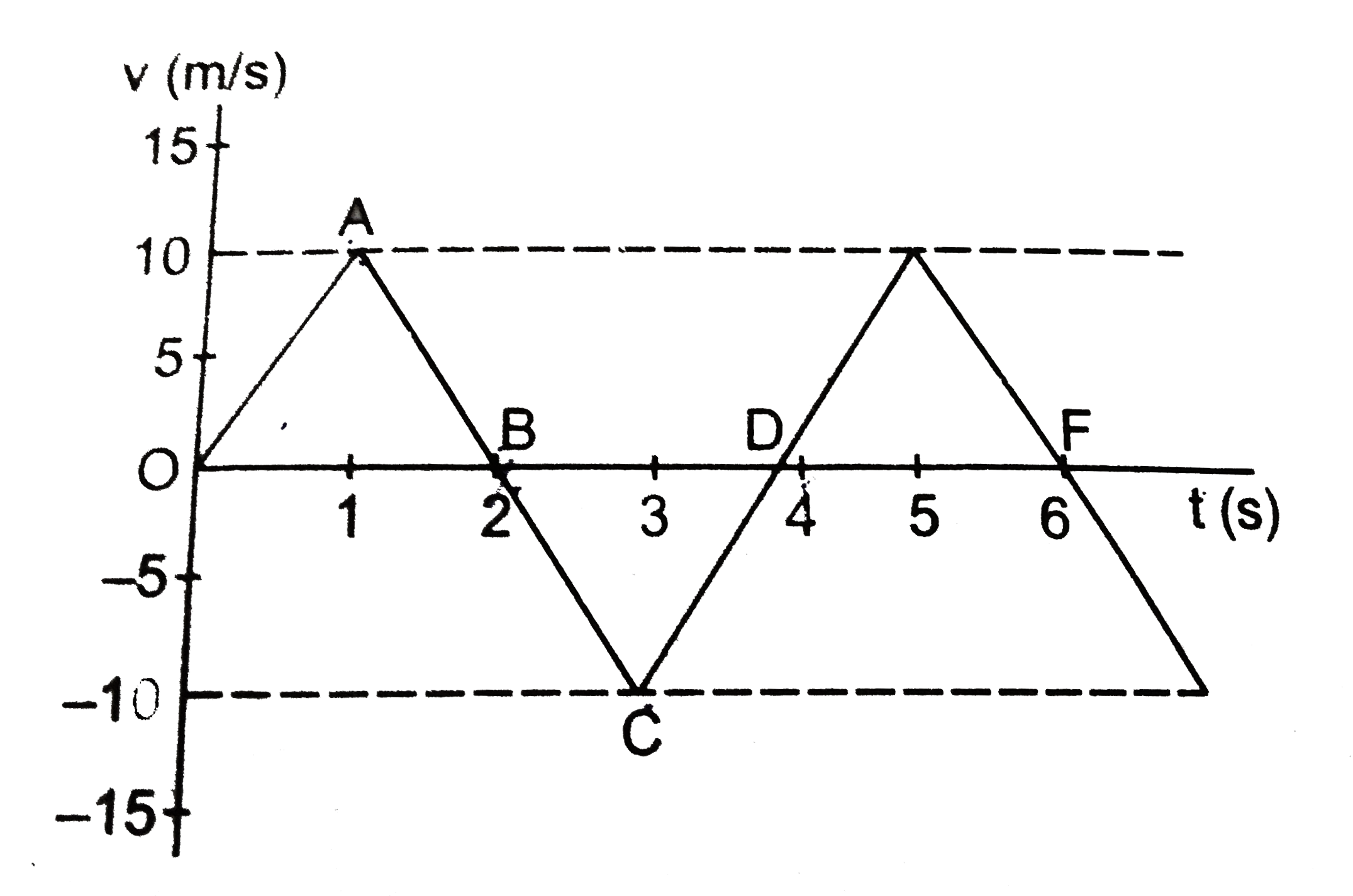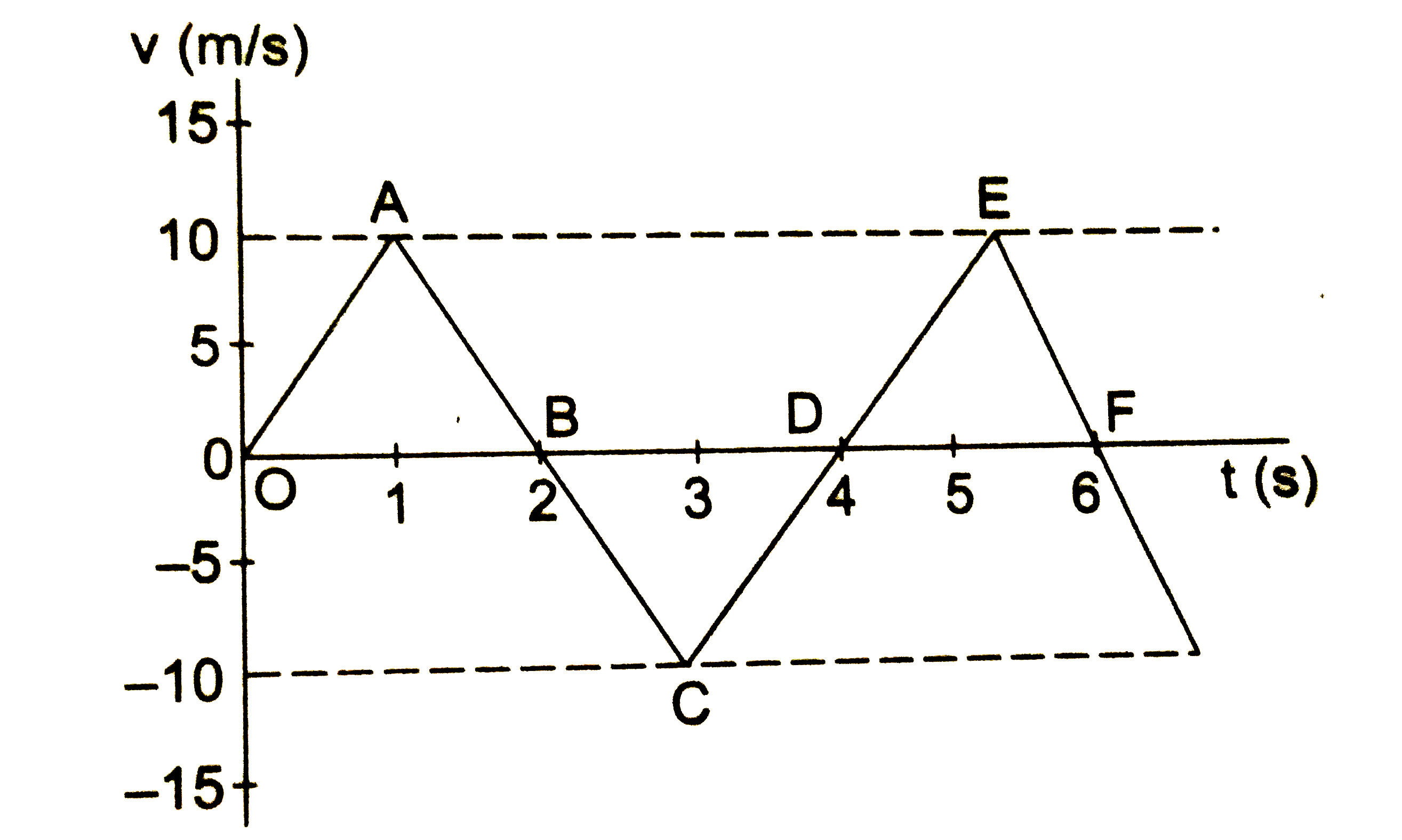From the veloicty time graph of a particle given in figure describe the motion of the particle qualitively int eh interval 0 to 4s. Find a. the distance travelled during first two seconds, b. during the time 2s to 4s, c. during the time 0 to 4s d. displacement during 0 to 4 s. e. acceleration at t=1/2 and f. acceleration at t=2s
 .Solution in Tamil
.Solution in Tamil
At t=0, the particle is at rest say at the origin. After that the velocity is positive, so that the particle moves in the positive x direction. Its speed increases till 1 second when it starts decreasing. The particle continues to move further in positive x direction. At t=2s, its velocity is reduced to zero, it has moved through a maximum positive x distance. Then it changes its direction, velocity being negative, but increasig i magnitude.At t=3s velocity is maximum in the negative x direction and then the magnitude starts decreasing. it comes to rest at t=4 s.
a. Distance during 0 to 2 s = Area of OAB
=12×2s×10ms=10m
b. Distance during 2 to 4s = Area of BCD = 10 m. The partile has mioved in negative x direction during this period.
c. The distance travelled during 0 to 4s=10 m+10m
=20m
d. displacement during 0 to 4 = 10 m+(-10m)=0
e. at t=1/2 s acceleration = slope of line OA=10 m/s^2
f. at t=2 s acceleration= slope of line ABC = - 10 m/s^2.
Topper's Solved these Questions
- BOOK - HC VERMACHAPTER - REST AND MOTION : KINEMATICSEXERCISE - Question for short Answer14videos
REST AND MOTION : KINEMATICS
- BOOK - HC VERMACHAPTER - REST AND MOTION : KINEMATICSEXERCISE - Objective -113videos
REST AND MOTION : KINEMATICS
- BOOK - HC VERMACHAPTER - REST AND MOTION : KINEMATICSEXERCISE - Exercises51videos
REST AND MOTION : KINEMATICS
- BOOK - HC VERMACHAPTER - PHYSICS AND MATHEMATICSEXERCISE - Exercises34videos
PHYSICS AND MATHEMATICS
- BOOK - HC VERMACHAPTER - ROTATIONAL MECHANICSEXERCISE - Exercises86videos
ROTATIONAL MECHANICS
Similar Questions
Galileo was punished by the Church for teaching that the sum is stationary and the earth moves around it. His opponents held the view that the earth is stationary and the sun moves around it. If the absolute motion has no meaing,are the two view points not equally correct or equally wrong?
07:47View SolutionA motor car is going due north at a speed of 50 km/h. It makes a 900 left turn without changing the speed. The change in the velocity of the car is about
03:18View SolutionA man goes 10 m due east and then 24 m due north. Find the distance of his current position from the starting point ?
02:03View SolutionA vector →A makes an angle of 20∘and→B makes an angle of 110∘ with the X-axis. The magnitude of these vectors are 3 m and 4 m respectively.Find the resultant
06:18View SolutionA wheel is making revolutions about its axis with uniform angular acceleration. Starting from rest, till it reaches 100 rev/sec in 4 seconds. Find the angular acceleration.
04:27View SolutionThe position of a particle moving on X-axis is given by
x=At3+Bt2+Ct+D.
The numerical values of A,B,C,D are 1,4,-2 and 5 respectively and I units are used. Find a. the dimensions of A,B, C and D b. the velocity of the particle at t=4s, the acceleration of he particle at t=4s, d. The average velocity during the interval t=0 to t=4s, the average accelerationduring the interval t=0 to t=4s.02:34View SolutionThe period of a particle in SHM is 8 s . At t = 0 it is in its equilibrium position. (a) Compare the distance travelled in the first 4s and the second 4s . (b) Compare the distance travelled in the first 2s and the second 2s .
08:21View SolutionThe displacement of a body of mass 2 kg veries with time t as S = t^(2) + 2t , where S is in seconds. The work done by all the forces acting on the body during the time interval t = 2s to t = 4s is
11:43View SolutionSuppose that a particle mvoes on a straight line so that is velocity at time t is v(t)=(t^(2)-2t)m//s . (a). Find the displacement of the particle during the time interval 0 le t le 3 (b). Find the distance traveled by the particle during the time interval 0 le t le 3 .
02:05View SolutionThe velocity of a paticle is given by the equation, v=2t^(2)+5cms^(-1) . Find (i) the change in velocity of the velocity of the particle during the time interval between t_(1)=2s and t_(2)=4s (ii) the average acceleration during the same interval and (iii) the instantaneous acceleration at t_(2)=4s .
02:07View SolutionA particle starts from rest with acceleration 2m/s2. The acceleratioin of the particle of the particle descreases down to zero uniformly during time -interval of 4s. The velocity of particle after 2s is
08:32View Solutionx -अक्ष पर चलते हुए एक कण का स्थान x=At3+Bt2+Ct+D के अनुसार बदलता है | SI इकाइयों में A, B, C एवं D के सांख्यिक मान क्रमशः 1,4,−2 तथा 5 है | (a) A, B, C तथा D के विमीय - सूत्र निकले | (b) समय t=4s पर कण का वेग निकालें | (c) t=4s पर कण का त्वरण निकालें | (d ) t=0 से t=4s के अंतराल में कण का औसत वेग निकाले | (e) t = 0 से t = 4s के अंतराल में कण का औसत त्वरण निकालें |
02:43View Solutionचित्र में x -अक्ष पर चलते हुए एक कण के वेग का समय के साथ ग्राफ दिखाया गया है |
(a) समय t =0 से t = 4s तक में कण की गति कैसी है, इसका वर्णन करे |
(b) पहले 2 सेकंड में कण द्वारा चली गई दुरी निकले |
(c ) t=2s से t=4s तक में चली गई दुरी निकले |
(d) t=0 से t=4s तक में चली गई दुरी निकाले |
(e) t=0 से t=4s तक में विस्थापन निकले |
(f) t=12s पर कण का त्वरण निकले |
(g) t=2s पर कण का त्वरण निकाले |
 03:26View Solution
03:26View SolutionFind the distance travelled by the particle during the time t = 0 to t = 3 second from the figure .
03:58View SolutionThe speed verses time graph for a particle is shown in the figure. The distance travelled (in m) by the particle during the time interval t = 0 to t = 5 s will be __________
View SolutionThe position of a particle moving on X-axis is given by
x=At3+Bt2+Ct+D.
The numerical values of A,B,C,D are 1,4,-2 and 5 respectively and I units are used. Find a. the dimensions of A,B, C and D b. the velocity of the particle at t=4s, the acceleration of he particle at t=4s, d. The average velocity during the interval t=0 to t=4s, the average accelerationduring the interval t=0 to t=4s.04:17View Solution

